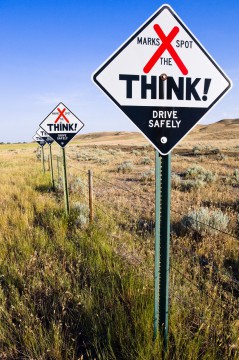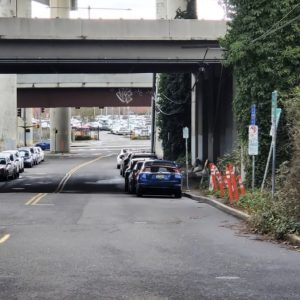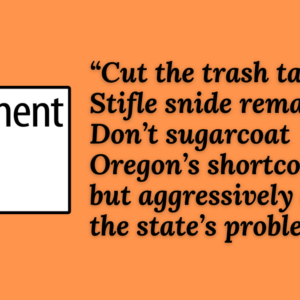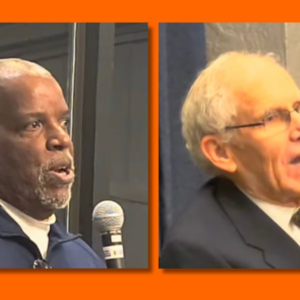
(Photo: GasFoodNoLodging.com)
I’ve rarely seen BikePortland readers as frustrated as many seemed to be beneath Wednesday’s post about the state of Oregon’s decision to remove temporary memorials to people killed on state roads because they (the memorials, not the people who were killed) might cause people to slow down or stop while driving.
A huge wave of upvotes backed many of the black-humor responses that followed.
But amid the well-written venting was an interestingly constructive suggestion: if Oregon feels that handmade memorials are distracting, maybe it should create its own official memorials instead — just like South Dakota does.
That was the comment from BikePortland reader GlowBoy, who (if I’ve been following his comments correctly) recently relocated from Portland to Minneapolis:
I think we should have a monument to remember every single person who’s been killed by (or on) a road facility.
Oregon ought to enact the same law requiring signs like those in South Dakota, marking EVERY SINGLE SPOT where a person has died on their roads. SD may not be considered a very progressive state, but I think it’s a brilliant idea and should be copied everywhere.
Advertisement
The SD signs have a big red “X” and “Marks the Spot”, followed by “THINK!” on one side and “WHY DIE?” on the other. The signs are actually fairly small and off to the side of the road, so presumably they’re less “distracting” than big cutouts, but they are there.
And when you come to an intersection with half a dozen of them scattered around it really does make you think.
GlowBoy went on to add that “Why Kill?” might be a better question than “Why Die?”
ODOT’s wanting to control signage along its roads isn’t unreasonable. But the context here — and the thing that memorials like South Dakota’s reveal — is that people are dying on the same streets again and again. These streets have much bigger problems than the unexpected appearance, for a few days, of ghosts.
Yes, we pay for good comments. This regular feature is sponsored by readers who’ve become BikePortland subscribers to keep our site and our community strong. We’ll be sending $5 and a little goodie bag to GlowBoy in thanks for this great addition. Watch your email!
— Michael Andersen, (503) 333-7824 – michael@bikeportland.org







Thanks for reading.
BikePortland has served this community with independent community journalism since 2005. We rely on subscriptions from readers like you to survive. Your financial support is vital in keeping this valuable resource alive and well.
Please subscribe today to strengthen and expand our work.
I was quite impressed with the comments in that thread. ODOT (and high viz mandates) sure do bring out the passions.
I am all for the “Why Kill!” addition signage. something progressive fro the new ODOT head to do. Mass quantities can be made for very low cost.
The cost of the signage is not especially high, but installation (labor) takes considerable commitment to the cause.
Seems a cut out of a person as a sign would actually be more effective in calming traffic, especially if it looked like it was going to cross the road.
In Chevy Chase, MD they have a police officer statue on one corner. It looks like it is about to the cross the road and is pointing. First time I saw it I immediately slowed and stopped because I thought someone was about to cross the street.
http://www.washingtonpost.com/wp-dyn/content/article/2008/10/08/AR2008100801835.html
I’ve heard in Ireland on some roads they have a black mark on the road sign closest to the death. Think windy roads and turn signs with black marks on them
The American Legion has been doing this in Montana for many years.
http://mtlegion.org/department/highway-fatality-markers.html
Yes, they do and its ridiculous. 70mph speed limits on 2 lane roads with no shoulders and then they mark all the fatalities with crosses. it seems like it would be a lot more sensible to make the speed limit 55 and not kill so many people. Some of the intersections are unbelievable with 10 or more crosses on each corner. Until a few years ago it was not illegal to drive while drinking from an open container.
Fact: Safety is an ODOT value.
Fact: ODOT has identified high crash corridors (ie SW Barbur Blvd).
Fact: ODOT knows high speed crashes result in more severe results.
Fact: ODOT knows lower speed crashes result in lower severe results.
Fact: The state mobilized resources rapidly to remove these signs which were there to remind people to drive safely (ie these signs were on SW Barbur Blvd).
Is it unreasonable to expect ODOT to take immediate action by addressing the high speed limit signs they maintain in high crash corridors? I just don’t understand why there is a total lack of urgency to do something about our high crash (high speed) corridors. The governor should do something if ODOT doesn’t and there is no reason it can’t happen tomorrow except will. Lower the speed limit tomorrow, take action, quit being so passive.
I don’t like how you’re framing this. “ODOT” is not a person that knows things. Most of their 5,000 employees don’t even know what a VRU is or think cycling safety is part of their job responsibility.
Out in the sweeping, undeveloped and uncluttered expanses of South Dakota countryside, the state’s signs reminding people to drive safe, may be fine. On the busy, already developed and very cluttered streets of Portland, signs like these don’t look like they’d be a good idea.
Roads too busy for things like this should have their speed limit halved. All of a sudden they become far less of an impediment.
ttfn,
speed limits in Portland are already halved. Some western states have 80 mph now on freeways. Montana used to be “unlimited” or something like that – not sure if that is the case or not today.
I told Brandie, who lives in Pine Ridge, South Dakota, about this article. She said, “Yeah they are all over the place out here. Some are even wrapped with garlen and solar lights by family memebers.”
I’m from SD. Those signs are everywhere. But, they are only for people killed by drunk drivers, not all motor vehicle accidents. I think they could work well in Portland. They can be placed in a way that doesn’t impede traffic. I like the idea.
I’ve been on the fence: remove or don’t remove the figures. Unfortunately, a pair of insensitive and uncaring vandals have helped us make the choice for removal. This may seem nonsensical, but actions such as this can lead to feeling victimized yet again and that is not acceptable.
🙁
Most of these roadside memorials soon turn into roadside garbage dumps as the trinkets pile up. Remove them.
Trinkets and garbage? —Really!?
Those trinkets and garbage are what makes those little crosses and ghost bikes human. They are testaments to who that person was and how much love surrounded them while they were alive – it what tells us the story both of the individual who died, and the evolving story of those that survived them.
Despite the horror of the event which places such memorials – there is a certain beauty to them, in a way – it is art at its best, it’s honest without pretense, stark, pure, public, untainted by commerce, and tells multiple stories on the frailty of the human condition and our emotions. A reminder that their are consequences to our actions as well as a reminder to live your life to it’s fullest because you don’t know when it’s your time to go.
Considering that nearly all these deaths were preventable, I find statements like this bordering on offensive, and indicates much of what I feel is wrong with people in general (on and off the roads) and that is a lack of grace or even just plain old common courtesy for others. After all these markers aren’t placed for the benefit of the victims, they are placed there for the living who most likely live in close proximity.
I guess we could make them all like the memorial to the young woman from Leggett, CA that is on Usul Rd (best cycling route along the NorCal coast that no one takes, by the way). It is a rock and mortar structure about three feet tall with a plaque commemorating her along with a warning of the dangers of drunk driving (she was a passenger). These could double as traffic calming structures. Would that be neat and tidy enough for you?
If the placement of roadside memorials, or any other objects, structures, signage, etc, detract from the safety and functionality of the road, rather than enhance it, they should probably be removed.
The picture, top of this story, showing the signs in South Dakota is an example of a placement that’s probably ok, because out in the open country, there isn’t a lot for people driving to be watching for. There, the signs may even break up the monotony of the endless road, in a way somewhat related to the Burma Shave signs of a bygone era, but with an indisputably more serious and important message to convey.
Not much in the Portland area, but I think I’ve seen pictures of roadside memorials elsewhere that grew to sizable proportions, with additions made over days by many people. They’re usually subject to the elements, so with time, they do get messy and ugly, something some people may find looks like garbage. Can their deteriorating and continued presence along roads where they’re placed, contribute rather than detract from the safety and functionality of the road? Some people may think so.
I guess I don’t think impromptu roadside memorials being a long term or permanent presence at points on roadsides where persons have become victims of traffic collisions, are a very good way of making efforts to bring about greater safety in using the road.
While the expression of emotion and compassion such memorials seek to convey is great, much of it as a constructive force for change will be lost where efforts to place memorials aren’t made in ways that promote positive and hopeful responses from people likely to see them. Grimy, decaying impromptu roadside memorials to traffic victims, don’t seem like something that would prompt positive and hopeful responses.
Clarification:
“…If the placement of roadside memorials, or any other objects, structures, signage, etc, detract from the safety and functionality of the road, rather than enhance it, they should probably be removed. …”
As in, ‘unreasonably’…detract from the safety and functionality of the road, and so on. Not including roadside memorials, or any other objects, structures, signage, etc, ideas for which have been submitted to, carefully considered and approved by whatever agency responsible for seeing such things don’t unreasonably detract from the safety and functionality of the road.
!?
Like our streetscapes right now are such vistas of beauty? We’ve turned our roads and streets into wastelands, devoid of people, of signs of life, of color, of individuality, of meaning. Along come small, quiet, jumbled memorials (SE 29th & Stark as of recently) and all you can say is bring in the garbage trucks?!
The city of Portland is fairly litter strewn and cluttered, but Oregon’s countryside is beautiful with color and life. I agree that the mouldering stuffed animals, 2×4 crosses and yellowing plastic flowers on DIY memorials diminish the beauty of rural Oregon. And it is easy to understand that the State of Oregon has a conflict in maintaining Christian shrines (crosses) on its highways. As far as adding clutter and visual distraction to urban areas, my 2 cents are worth just that, but I don’t like it. Get a headstone in a cemetery, write a poem, advocate like Kristi is doing in a meaningful and effective way. The public domain is not a billboard for personal grief
except the billboards, which for (well-understood $$) reasons are deemed perfectly acceptable by the cheeses in many of those non-urban locations. I’ll take a mouldering teddy bear any day over another football field sized advertisement for a retirement community or a casino.
Point taken, I suppose unsullied vistas is not an option.
Billboards generally are mounted up high, away from road user’s direct angle of vision to the road, posing relatively less of a distraction than impromptu memorials sited at the scene of collisions.
Deterioration of the aesthetic beauty of road and streets, it might be said by some that neglected traffic collision memorial contribute to, is I’d say, a secondary issue. Not so significant if memorials so sited, didn’t distract people from the business of using the road safely.
By the way, efforts to not have billboards and commercial signs excessively clutter and diminish roadside aesthetics, has definitely been a priority in our area for at least a couple decades. I can say from first hand experience, that Beaverton, I think by introducing ordinances to accomplish it, phased out many of the huge, overbearing signs along for example, Canyon Rd and Beaverton Hillsdale Hwy. The city made businesses use smaller signs, and bring them down some from the height they at one time had. There’s very few billboards in central Beaverton. There’s still one up on West Slope, but I believe that’s Multnomah County. Also one about a half mile west, which may be Washington County. Definitely became a less distracting, more beautiful place to live and travel through, with the disappearance of most of the big obnoxious signage.
“up high, away from road user’s direct angle of vision to the road, posing relatively less of a distraction”
“The city made businesses […] bring them down some from the height they at one time had.”
Hm.
“The public domain is not a billboard for personal grief”
And I agree with that, too. My little brother drowned in the Pacific fourteen years ago, and it never would have occurred to us to erect a memorial on the public beach or near there. We took a large smooth rock from the beach and had his name carved into it. This is the headstone in the cemetery where he’s buried.
🙁
So sorry for your loss
South Dakota has been erecting those signs since 1979. The program started as an effort to show just how great a problem drunk driving is, but I’m disappointed the program counteracts that effort, as well – the signs are removed when worn out or when a highway is reconstructed, and then only erected again if the victim’s family requests it be. The program could otherwise be a stronger reinforcement of our collective memory, which I find tragic given current global affairs and US citizens’ reactions.
Those signs will cost dollars.
So…
Install the signs: if they are likely to reduce dangerous driving (and by extension, injuries and fatalities).
Do not install the signs: if they are unlikely to… (see above).
Data, anyone?
Wow, it’s a great honor to have my comment recognized. I’ve thought this was a great idea ever since I first saw these memorials, which (if they started in 1979) must have been when they were a pretty new thing.
Of course installing them will cost some money, but so does losing a human life. It seems to me we could do just a little more for traffic victims than simply cleaning up the mess and making it look as if nothing happened there.
Subsequent visits to South Dakota (in 1987, 2000 and 2012) have reinforced my belief in these memorials. And since, as pointed out, I now live in Minneapolis, needless to say I’d like Minnesota to have such a law as much as I’d like Oregon to.
Install a red speed bump for each fatality.
Memorials such as crosses where people are killed is common throughout the US on rural roads. I assume they are put up by the families. They usually have names on them.
I do agree with wsbob above – they’re ok in rural areas, but not acceptable in cities which already have too much going on to be safe. Maybe a compromise in cities would be to have one sign at each corner indicating the number of people who have died from there to the next corner straight ahead. But it should be distinct enough that drivers know not to take the time to read it – maybe pink or something.
Info:
https://en.wikipedia.org/wiki/Roadside_memorial
http://www.wsdot.wa.gov/Operations/Traffic/Signs/duisign.htm
http://www.transportation.wv.gov/highways/traffic/roadsidememorials/Pages/default.aspx
https://www.codot.gov/programs/memorial-sign.html
http://www.scdot.org/getting/community_roadside_memorials.aspx
http://www.virginiadot.org/info/roadside_memorial_signs.asp
http://wisconsindot.gov/Pages/doing-bus/real-estate/roadsides/memorials.aspx
Being from SD, as well, I often while growing up heard the same reason for the signs, but have since learned that is false:
-http://www.sddot.com/services/memorials/Default.aspx
-https://dps.sd.gov/enforcement/accident_records/images/FAT-MARK.DOC
Are you still in SD? It’s nice to see another SD name on this site.
Error threw that off – ’tis a reply to Rachel Cameron’s post from the 20th.
I get that they is a maintenance requirement but I find them incredibly effective. I’ve never once driven by a memorial and not taken pause and considered my safety and the safety of others.
In Montana, MT DOT puts up small white crosses at the roadside to mark the location of a fatal accident. The official road map mentions them. Ride the Amtrak Empire Buikder thru Montana, and you’ll see several along US-2, which runs next to the rail line for most of the way thru MT and ND. Quite a few are grouped around railway crossings…marking those who died trying to beat the train across.
Interesting. Do many people take issue with the use of crosses since they are generally associated with Christianity?
Not that I’ve heard of.